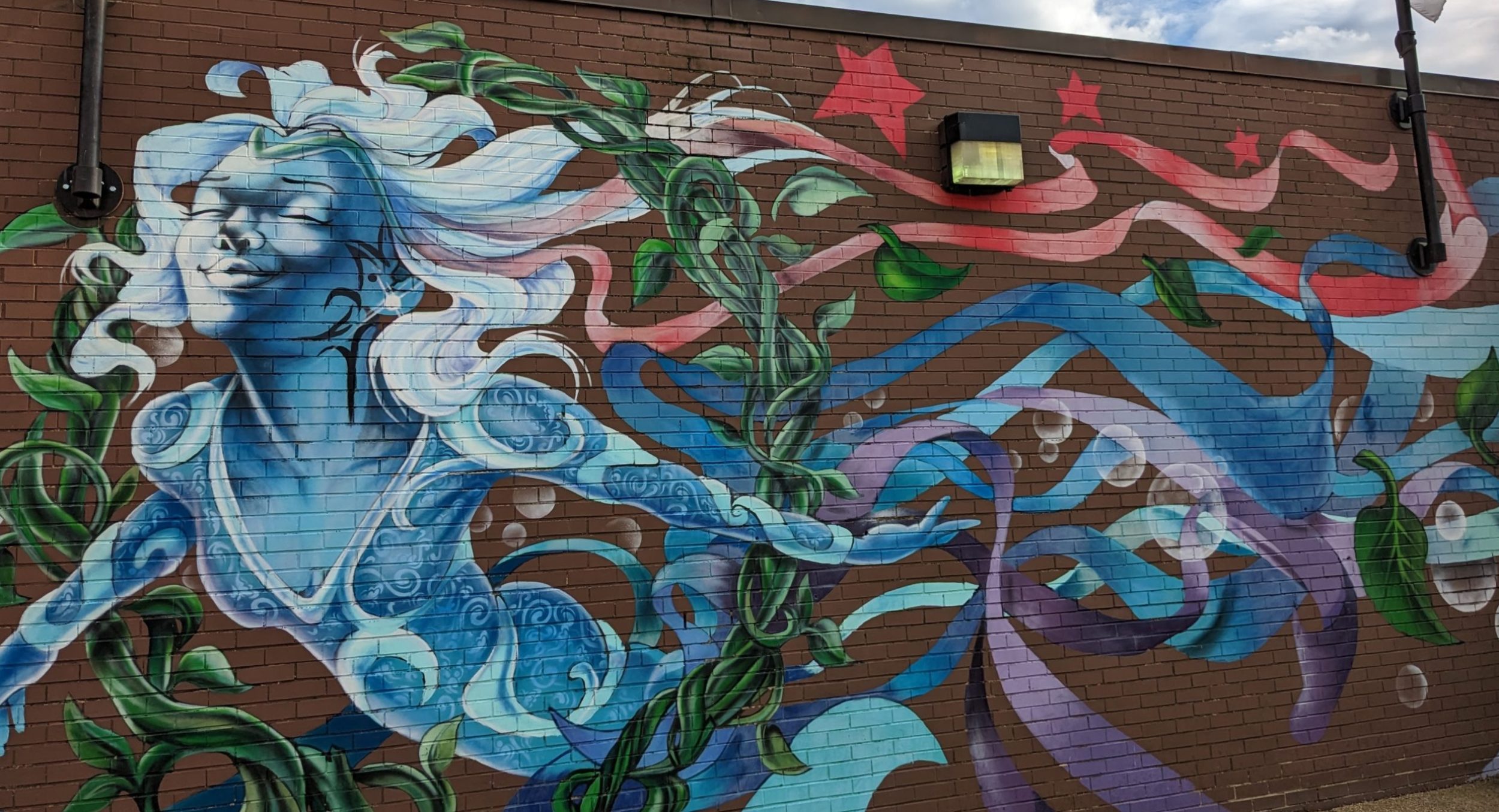 St. Joseph has a far better deal in the paintings of colonial Peru than he does in much of European art.
St. Joseph has a far better deal in the paintings of colonial Peru than he does in much of European art.
Look to the left to see how Italian Renaissance artist Botticelli depicted Joseph in a painting done around 1476. Stooped and aged, Joseph stands off to the side of the action.
Joseph fares even worse in the 1528 painting below by another Italian artist, Andrea del Sarto, seen below. Botticelli’s Joseph looks as if he could at least l ead the donkey for Mary, even if he couldn’t handle much else. In del Sarto’s painting, Joseph is a nervous wreck, his hand clutching his throat, arms folded across his body. This Joseph will be one more burden for the weary Mary in the painting.
ead the donkey for Mary, even if he couldn’t handle much else. In del Sarto’s painting, Joseph is a nervous wreck, his hand clutching his throat, arms folded across his body. This Joseph will be one more burden for the weary Mary in the painting.
Peruvian painters instead put Joseph front and center, as seen in this little painting below. And, he’s a vigorous dark-haired handsome Joseph who’s often seen caring for Jesus alone.
The makeover stems partly from a shift in how the Spanish depicted Joseph in the 16th and 17th centuries, and partly from how well the saint’s story fit with beliefs long held by the Inca before the Spanish arrived in the New World.
 The painting to the left, done in Spain by El Greco around 1597, shows a Joseph who combines great strength and incredible tenderness. El Greco stretches out Joseph and elongates him, something that the painter routinely did with his subjects. Still, Joseph looks powerful and steady, more connected to the earth than many of El Greco’s subjects. Joseph’s hand on the Christ child has a touch that seems at once soft and sheltering.
The painting to the left, done in Spain by El Greco around 1597, shows a Joseph who combines great strength and incredible tenderness. El Greco stretches out Joseph and elongates him, something that the painter routinely did with his subjects. Still, Joseph looks powerful and steady, more connected to the earth than many of El Greco’s subjects. Joseph’s hand on the Christ child has a touch that seems at once soft and sheltering.
Ardent Promoter
Joseph had an a devoted fan in one of the most famous women in Spanish history, Theresa D’Avila (1515-1582). She seems like quite a character. She could write with incredible grace –“Let nothing disturb thee; Let nothing dismay thee; All thing pass; God never changes” — and then sound like a modern talk-radio host when it came to those people who had opposing views, Protestants in her case.
Art historian Christopher Wilson* wrote on how Theresa once worried that it was an “imperfection” to own an ornate painting until the Lord told her not to get rid of something that awakens love. “Theresa said that the Lord told her that Lutherans had gone astray because the devil took from them all means of awakening,” Wilson wrote. An effective reformer of Spanish religious life, the influential Theresa called Joseph the “glorious patriarch,” and claimed his personal support helped her many times.
The Inca had their own reasons for taking a liking to Joseph. The Incan religion  said that they descended from Manco Cápac, a son of the sun god, who carried a golden staff. Joseph sometimes carried a stalk of lilies in the paintings that reached Peru from Europe.
said that they descended from Manco Cápac, a son of the sun god, who carried a golden staff. Joseph sometimes carried a stalk of lilies in the paintings that reached Peru from Europe.
Manco Cápac’s story involved wanderings in search of the right home for the Incas, and Joseph was often seen leading his family to safety in Egypt. So Theresa D’Avila and Manco Cápac helped make Joseph one of the most popular subjects in the paintings of colonial Peru, such as the one seen to the right. This is an example of what’s known as Cuzco Style of painting, named for the Inca city where many Peruvian artists mixed European models of paintings with their own customs and came up with something pretty grand.
The Brooklyn Museum owns this painting. Its Web page for this painting points out that the sandals that Jesus wears are made in an Incan style.
 A border of rose and lilies once framed the St. Joseph painting, the Brooklyn Museum’s Web page points out. Early Cuzco School paintings in general don’t make serious attempt to show their subjects in a landscape or realistic setting. Instead, a flat quality is typical for these paintings, which first were developed for converting the Inca to Catholicism. Many of the Cuzco School paintings devote elaborate detail to the clothes worn by the saints and virgins, perhaps a carryover from the Inca’s own great love for textiles. Among the Inca, certain fine materials were reserved for the elite. The painters in the Cuzco style often showed their subjects decked with flowers or framed by them, or decked and framed with flowers as in this Cuzco-style painting of the Virgin of Pomata, shown to the left. Her headdress looks like the feather ones worn by the Incas.
A border of rose and lilies once framed the St. Joseph painting, the Brooklyn Museum’s Web page points out. Early Cuzco School paintings in general don’t make serious attempt to show their subjects in a landscape or realistic setting. Instead, a flat quality is typical for these paintings, which first were developed for converting the Inca to Catholicism. Many of the Cuzco School paintings devote elaborate detail to the clothes worn by the saints and virgins, perhaps a carryover from the Inca’s own great love for textiles. Among the Inca, certain fine materials were reserved for the elite. The painters in the Cuzco style often showed their subjects decked with flowers or framed by them, or decked and framed with flowers as in this Cuzco-style painting of the Virgin of Pomata, shown to the left. Her headdress looks like the feather ones worn by the Incas.
 The Incas took on the new saints of the Spanish, just as they earlier had absorbed and modified gods of the fellow South American peoples that they had conquered. This mixing of gods and beliefs and art is the norm in human history. The word “Spanish,” after all, summarizes the result of blending over centuries the traditions of Germanic tribes with those of Moors and Jews from North Africa and the Mediterranean, with some hints of Rome.
The Incas took on the new saints of the Spanish, just as they earlier had absorbed and modified gods of the fellow South American peoples that they had conquered. This mixing of gods and beliefs and art is the norm in human history. The word “Spanish,” after all, summarizes the result of blending over centuries the traditions of Germanic tribes with those of Moors and Jews from North Africa and the Mediterranean, with some hints of Rome.
And, the Spanish brought more than their own brand of “the European” to the Inca. Fanciful and unrealistic Flemish prints of soldiers made it the New World. These had great appeal for the young artists painting in Cuzco, who turned these armed dandies into archangels.
Wings and feathers are added to the portraits of men in clothes that no one would wear to battle. The archangels of the Cuzco school wear brocade, silk and lace. Some carry swords and others hold a long gun known as an arquebus, as shown in painting to the right from the collection of Bolivia’s National Museum of Art in La Paz.
 Archangels predate Christianity, having made appearances earlier in Judaism and a religion practiced in what’s now Iran in the centuries before the birth of Christ, known today as Zoroastrianism. People seem to find comfort in the idea of winged messengers of God, maybe from looking up at the birds in the endless sky. This is one of the common themes that mankind likes and repeats across time and continents, along with creation stories and things grouped into threes.
Archangels predate Christianity, having made appearances earlier in Judaism and a religion practiced in what’s now Iran in the centuries before the birth of Christ, known today as Zoroastrianism. People seem to find comfort in the idea of winged messengers of God, maybe from looking up at the birds in the endless sky. This is one of the common themes that mankind likes and repeats across time and continents, along with creation stories and things grouped into threes.
 Cuzco School paintings show three versions of Christ in the same canvas. These paintings reminded me of a pictures of the Hindu trinity, as seen to the right in an image copied from Wikipedia. Brahma, Vishnu and Shiva are about the same size and grouped together. I don’t think there’s any connection between the Cuzco School and the Indian trinities, other than people around the world liking things grouped in threes.
Cuzco School paintings show three versions of Christ in the same canvas. These paintings reminded me of a pictures of the Hindu trinity, as seen to the right in an image copied from Wikipedia. Brahma, Vishnu and Shiva are about the same size and grouped together. I don’t think there’s any connection between the Cuzco School and the Indian trinities, other than people around the world liking things grouped in threes. I’ve never heard a better explanation for why humans like trios that the lines Schoolhouse Rock’s “Three is a Magic Number” about how that three -man, woman and child – “is a family.”
 y of paintings of the Holy Family, such as the one below from the Jackson Auction site of the Holy Family. This is not the Madonna and Child with a Joseph off to the side, two plus a somewhat distant one, which is common in Europe. It’s three, united.
y of paintings of the Holy Family, such as the one below from the Jackson Auction site of the Holy Family. This is not the Madonna and Child with a Joseph off to the side, two plus a somewhat distant one, which is common in Europe. It’s three, united.*Sometimes you’re better off breaking a resolution. I’m trying to make a dent in my stack of unread books and so have tried not to buy more. Luckily for me, Books America put a copy of a 1991 exhibition catalog out on the cart in front of its 22nd Street store last year. For days, the lovely front cover of “Temples of Gold, Crowns of Silver : Reflections of Majesty in the Viceregal Americas” called to me as I walked by. I finally broke down and bought it, and it made my trip to Peru and Bolivia so much richer. In the blog above, I refer particularly to essays in the book contributed by two George Washington University scholars, Christopher Wilson’s “Strong Men and Frontiers : Conquest of the Spanish Mystics” and Barbara von Barghahn’s “A Crucible of Gold : The `Rising Sun’ of Monarchy in the Blending of Cultures.”

